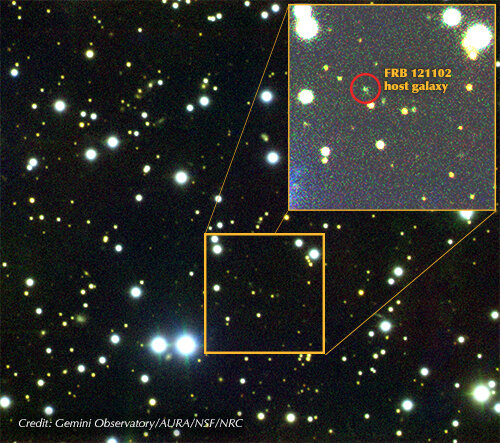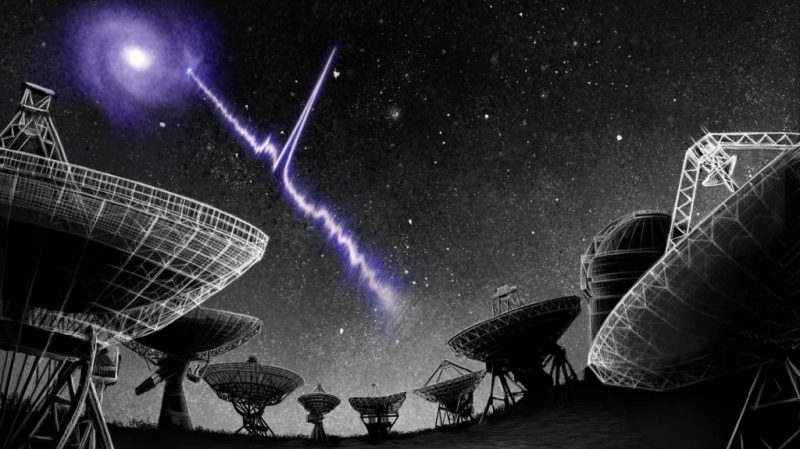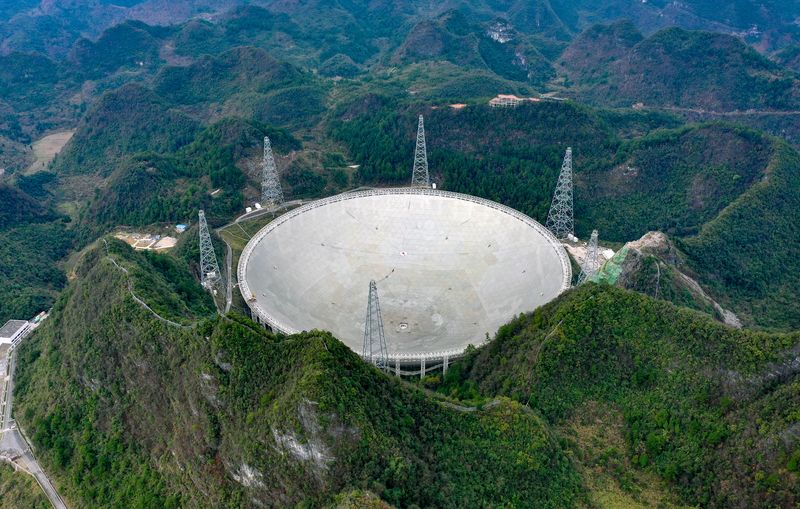
A repeating fast radio burst (FRB) woke up again in recent months, just when scientists had predicted it would, according to scientists in China, who studied it with the Five-hundred-meter Aperture Spherical radio Telescope (FAST), now the world’s largest dish-type radio telescope. The FRB being studied is called FRB 121102. It’s one of a few so far that have been found to repeat on a regular cycle. FRB 121102 had previously been found to repeat on a 157-day cycle. The new observations also refine that time period a bit more and suggest an ending to the current period of activity of sometime between August 31 and September 9, 2020. Will these astronomers’ predictions come to pass?
The new report on FRB 121102 comes from astronomer Pei Wang of the National Astronomy Observatory of China (NAOC), who used FAST to monitor FRB 121102 on several dates between March and August 2020. The findings were posted to The Astronomer’s Telegram on August 21, 2020.
As reported in Science Alert on August 24, from mid-March to late July 2020 the FRB had been silent, as expected. Previous observations showed that it would remain in an inactive phase for about 67 days, then “turn on” again for another 90 days, during which time it would repeatedly emit intense radio flares. The 157-day cycle then keeps repeating. On August 17, Wang’s team detected new activity again with FAST, at least 12 bursts, right about when expected.
Now the question is, when will the current period of activity end?

The timing of the new series of bursts from FRB 121102 supports previous observations from a team led by Marilyn Cruces of the Max Planck Institute for Radio Astronomy, as well as by University of Manchester astronomer Kaustubh Rajwade and his team. It was Rajwade who first discovered the periodicity of FRB 121102. Then, the cycle was calculated to be every 157 days. Cruce’s team, meanwhile, has calculated a cycle of 161 days, and submitted a new preprint paper to arXiv on August 8, 2020. They detected 36 bursts from FRB 121102 using the Radio Telescope Effelsberg between September 2017 and June 2020.
According to that new paper, the active period for FRB 121102 should be between July 9 and October 14, 2020.
Wang’s team, however, using data from both Cruces and Rajwade, has calculated a periodicity of 156.1 days. Wang said in a statement:
We combine the bursts collected in Rajwade et al. (2020) and Cruces et al. (2020) with these newly detected by FAST in 2019 and 2020, and obtain a new best-fit period of ~156.1 days.
If Wang is right, then the current active phase of FRB 121102 should end between August 31 and September 9, 2020. But if it doesn’t, that would suggest that either the periodicity isn’t actually real, or that it has changed somehow. The calculations may also need a bit of further refinement. As with other FRBs, this one will continue to be monitored. As noted in The Astronomer’s Telegram:
With this putative period, the projected turn-off date is around August 31-September 9, 2020. Alternatively, if the source is continuously on after the projected turning-off time, it suggests that the putative period of the source is not real or has evolution. We encourage more follow-up monitoring efforts from other radio observatories.
Watch for more news on FRB 121102. It’ll be very interesting to see if it turns off as predicted by Wang’s team.

Fast radio bursts are one of the weirdest phenomena yet discovered in our universe. They are very brief but very powerful blasts of radio waves, lasting only a few milliseconds (a millisecond is a thousandth of a second) and scientists don’t yet know what causes them. Most seem to just give off a single burst, and then are never seen again. Others repeat, however, and fewer still repeat on a regular basis. A typical FRB can generate as much energy in a single millisecond burst as the sun does in 80 years!
Last February, another repeating FRB was announced, FRB 180916.J0158+65, and this one has a cycle of 16 days. It was observed by scientists using the Canadian Hydrogen Intensity Mapping Experiment (CHIME) radio telescope in British Columbia, Canada. CHIME observed one to two bursts per hour, a process that continued for four days. But then, for the next 12 days or so, there was no activity at all. The cycle then repeated.
Some 28 bursts were recorded by CHIME in total for this FRB, from September 16, 2018, to October 26, 2019. It is in a spiral galaxy 500 million light-years away, the closest known FRB found so far. The identification of the specific location was previously published in Nature on January 6, 2020.

The first known FRB, called FRB 010724 or the Lorimer Burst, was found in 2007, in data from the Parkes radio telescope in Australia. Over 100 FRBs have been detected so far, originating in distant galaxies. What causes them is still a mystery, but theories include unusual phenomena associated with rapidly rotating neutron stars or merging black holes, or perhaps something that really is completely new to science. There is also still the popular possibility of extraterrestrial intelligence being involved, but so far there is no direct evidence for that, and FRBs appear to be widely distributed among far-flung galaxies, making a natural explanation more likely.
The re-detection of bursts from FRB 121102, as predicted, is more solid evidence that at least some FRBs repeat on a regular basis. This provides valuable clues as to what is really going on with these mysterious objects.
Bottom line: FRB 121102, one of the few known repeating FRBs, woke up and started emitting radio waves again, just when scientists in China expected it to. These scientists predicted a turn-off date for FRB 121102 between August 31 and September 9, 2020. It’ll be interesting to see if they are right!
Source: FRB121102 is active again as revealed by FAST
Source: Repeating behaviour of FRB 121102: periodicity, waiting times and energy distribution











